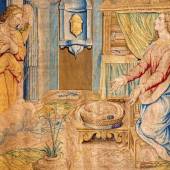Philippines: 500 Years of Christianity in Cebu
This was the last event of the Jubilee Year, which celebrated 500 years of Christianity in the Philippines, Asia's largest Catholic country. There were a series of mission-related presentations at the Second National Mission Congress (April 17–20, 2022).
Father Ramon Echica, a historian, discussed his views and thoughts on the mission in Cebu, central Philippines, the site of the first baptism of Filipinos 500 years ago.
In his talk, he talked about the past and then, on occasion, linked it to the current situation.
He begins by stating that many Cebuanos are familiar with the story of Christianity's origins in Cebu. In 1521, the Ferdinand Magellan (a Portuguese explorer) expedition arrived on the island through some strange twists of faith.
Echica described it as a "strange twist of faith," given that the expedition's objective was not Christian evangelization. The islands that have become known as the Philippine archipelago were not the expedition's final destination.
"It was bound for the Moluccas," he recalled.
Nonetheless, Echica stated, Magellan decided to stay for a while and regale the indigenous people with tales of the Spanish empire's might for various reasons, including Cebu's strategic location relative to the neighboring islands.
However, he became involved in local political conflicts, the priest said.
He was convinced that while Magellan's voyage did not result in rapid colonization of the Philippines islands, it did introduce them to Spain as a potential future expansion point.
However, once he arrived in what is now known as Cebu, the natives were baptized, said Father Echica.
He recalled that among those baptized was the queen, Humabun's wife. The queen requested the image of the Infant Jesus shortly before her baptism.
From this point in time, he added, the image seen by the Miguel López de Legazpi, (a Spanish explorer) expedition in 1565 was very definitely the same.
According to him, the Legazpi expedition had no intention of staying on the island (Cebu) for the long term. It was seen as a sign from God that they should remain in the place because God was genuinely waiting for them.
When the Augustinian chronicler Gaspar de San Agustin arrived, he was not a member of the Legazpi expedition. He came later and had just received his copy.
He reported that the Legazpi expedition encountered some resistance when it arrived at its destination. As part of a deal that was signed by Tupas (the chief), Legaspi agreed to end the war by signing the treaty.
Then he added that in 1595, along with the dioceses of Nueva Caceres and Nueva Segovia, Cebu was made a suffragan diocese of Manila.
He explained that in 1595, at the invitation of the people of Cebu, the Jesuits arrived to begin the evangelizing process.
It was decided that the islands of Cebu and Panay would be evangelized by Augustinians, while Jesuits would evangelize Bohol, Leyte, Samar, and Mindanao.
The Franciscans would focus on the Bicol area, and the Dominicans would look after Northern Luzon.
According to him, the different missionary groups split the Philippines into other work areas to help people learn their language.
However, Filipino history textbooks condemn Spain for not teaching the indigenous Castilian language.
This, he thought, was a claim made by propagandists who claimed that Spain was frightened that teaching Spanish to the natives would lead to the spread of liberal western ideas.
According to history, Spain's colonization of the Americas was seen as an unfavorable comparison.
For a variety of reasons, there may be some truth to some of this history, but he thinks it does not tell the complete tale.
However, one of the Spanish missionaries’ intentions was to convert the Filipinos to Catholicism. The missionaries also desired to learn the local languages to accomplish their goal.
He explained that missionaries go about evangelizing by getting to know the local languages (Cebuano) and cultures. It's a trend that's still going strong today.
The last part of this presentation talked about the more resistant shadows to change.
He believes that institutions naturally tend to be complacent and resist change.
He referred to one of them as the Basic Ecclesial Communities (BEC). There are several distinct types of BECs.
The first type of BEC is based on tradition, and it is usually made up of the parish priest or the bishop himself. This class will look at the Bible, the liturgy, and the role of the laity in church work.
The second type of BEC is developmental BECs. They attempt to connect the Bible to contemporary social issues.
An attempt is made, to begin with, a phenomenological description of the social conditions and then to read the word of God from that description.
They use specific philosophical and methodological frameworks to think about social problems differently.
He said that these BECS are a sign of resistance to change in Cebu, where most BECs are parish-based and fall into the first group. – Kasmir Nema
Radio Veritas Asia (RVA), a media platform of the Catholic Church, aims to share Christ. RVA started in 1969 as a continental Catholic radio station to serve Asian countries in their respective local language, thus earning the tag “the Voice of Asian Christianity.” Responding to the emerging context, RVA embraced media platforms to connect with the global Asian audience via its 21 language websites and various social media platforms.














